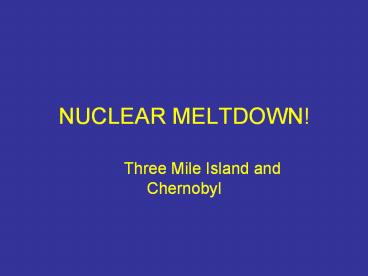NUCLEAR MELTDOWN! - PowerPoint PPT Presentation
1 / 20
Title:
NUCLEAR MELTDOWN!
Description:
NUCLEAR MELTDOWN! Three Mile Island and Chernobyl Draw Backs to Nuclear Power Thermal Pollution Nuclear Waste Meltdowns Three Mile Island Chernobyl What is a Meltdown ... – PowerPoint PPT presentation
Number of Views:151
Avg rating:3.0/5.0
Title: NUCLEAR MELTDOWN!
1
NUCLEAR MELTDOWN!
- Three Mile Island and Chernobyl
2
Draw Backs to Nuclear Power
- Thermal Pollution
- Nuclear Waste
- Meltdowns
- Three Mile Island
- Chernobyl
3
What is a Meltdown
- A meltdown occurs if a reactor loses coolant
water, exposing the reactor core. - The temperature reaches 2800C, the fuel melts,
and becomes a white-hot molten mass. - This melts its way through all the containment
vessels to the earth below
4
Three Mile Island
- March 29th ,1979
- Harrisburg, PA
5
What Happened
- Cleaning a feed water tank
- Clogged, tried to blow out the clog with an air
compressor - Compressor lines had been connected to a water
line - Water went into the air lines
6
Continued
- Water caused the valves to close (designed not to
close, but never wired) - Heat and pressure built up (couldnt vent)
- Water couldnt reach the generators(valves
closed!) - Back-up valves had been closed a week earlier
(they were never closed) - Indicator light covered with something
7
And then what?
- A second indicator light showing a false OK
signal - Operators struggled with mixed signals from
control panel - Finally realized the valve problem and opened
them.
8
Results
- Containment building flooded with radioactive
water - Tremendous build up of steam and gas (hydrogen
and possibly oxygen) - Worried of possible explosion- made the decision
to release radioactive gas into the atmosphere - Water had also been released, fuel rods were
damaged. - No immediate deaths
9
Chernobyl
- April 26, 1986
- former USSR (now Ukraine)
10
What Happened?
- Test to see if the plant could produce enough
power to run itself during a power outage - But not everyone was informed
- Lack of cooling and too much pressure caused a
power surge (massive heat)
11
What happened continued
- There were two explosions
- The first explosion was a steam explosion
- Second explosion under debate- hydrogen?
- fuel, core components, structural items sent into
atmosphere - Radioactive and hot material set into
atmosphere - The plume of smoke went 1 km into the air
12
The Fires
- Several broke out after the explosions
- The fires - normal and graphite.
- Graphite fire caused the biggest release of
radiation - Graphite fires too hot for water.
- Dropped 5000 tons of boron, dolomite, sand, clay
and lead to extinguish the graphite fire. - Extinguished finally after 20 days.
13
Radiation Release
- It is estimated that all of the xenon gas, about
half of the iodine and cesium, and at least 5 of
the remaining radioactive material in the reactor
core was released. Most of the released material
was deposited close by as dust and debris , but
the lighter material was carried by wind over the
Ukraine, Belarus, Russia and to some extent over
Scandinavia and Europe. - Iodine-131 and cesium-137 were the main
radioactive hazards.
14
(No Transcript)
15
In Conclusion
- reactor design was poor from the point of view
of safety and unforgiving for the operators - killed more than 30 people immediately
- high radiation levels in the surrounding 20-mile
radius - 135,00 people had to be evacuated
- 64 of all Ukrainian thyroid cancer patients age
15 of younger live in the most contaminated
regions.
16
What are the chances Today?
- The chances of this happening have been estimated
at one in 100 million 'reactor years. - A fuel meltdown might be expected once out of
20,000 years of reactor operation. - In 2 out of 3 meltdowns there would be no deaths.
- In 1 out of 5 meltdowns there would be 1000
deaths, - In 1 out of 100,000 meltdowns there would be
50,000 deaths. - Air pollution from coal-burning power plants
causes tens of thousands of deaths a year. - There would have to be 25 meltdowns a year for
nuclear power to be as dangerous as coal.
17
Nuclear Power Sites in U.S.
18
Daily Radiation
19
Where you live
20
Radiation Survey































